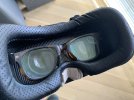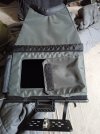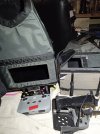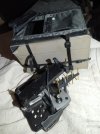It's been a LONG winter and I'm finally getting the urge to go back out and fly. I had some ailments that kept me inside all winter. So both boredom and curiousity collided and I decided I wanted to try a pair of those Magimask/Moviemask/Dronemask (all the same product. A little pricey but I haven't filled up the gas tank in over a month.
What got me curious about the DroneMask last year was that it didn't require a special program to use. No Litchi or DroneVR required. You can fly it with DJI fly or any other interface. How did it compare to the $28 VR goggles I got and reviews last year? While preliminary, the answers are mostly in. There are pros and cons to both types of non-DJI FPV/VR goggles.
First the Dronemask:
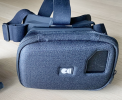
It's well built, but heavy. 450 grams, which wasn't noted in the specs. It's pretty easy to use. Clamp your phone in, turn on Fly, Go4, Litchi (in normal mode and you're ready to go. It has focus adjustment that moves the outer housing closer or further away. I you happen to need reading glass magnification it moves further away. However the it creates a longer lever arm on the "fulcrum" of the straps that hang on your head. That increases perceived weight significantly. In my case I use an iPhone XR which itself weigh 250 grams. So I'm hanging 700 grams on my head. However it has GOOD adjustable straps so at least it stays put. They didn't skimp on materials but you pay for it with weight.
It works as described. Open the program, set the settings close it up and go. The one other big negative that I see is that the closure is used with zippers. Since the phone is held in place inside, a "clip" closure system would have been far more convenient. With drones that have the Mini 2 type controller it can be a pain because you don't have C1 and C2 buttons and the toggle and two scroll wheels like the Mavic 2 does. The good news is that since the phone is held in place you can pop open the front, make the changes and then zip it up a bit. The other thing is that I found it too heavy to stay on top of my head when I wanted to eyeball the drone.
Now the $28 VR goggles...

I've been using the Pecosa brand of VR Goggles and out of the box found them needing a lot of fixes. But $28? So I decided to stick with them for the time (last year). The thing is with VR Goggles you need an interface that has a split screen function, unlike the Dronemask (you are just looking at the phone screen, so you can use with any program- even regular movies/tv from your phone. The two programs that I found worked well were Litchi and DroneVR. I had been waiting until recently until Litchi supported the Mini 2. I'm not sure if DroneVR caught up yet (though it works great with my Mavic 2).
The Pecosa VR's weigh 291 grams, 160 grams lighter. These were lighter than the first pair of VR goggles I bought and returned, specifically because of the weight (and quality) issues. It has a pop-off front which lightens it up some if you take it off. It's held in magnetically, so I installed a tab to pop it off easily.
The main issues that I have with the Pecosa is comfort (out of the box) and adjustability for presbyopia (needing reading glasses). It's maximum adjustment wasn't enough for my modest presbyopia. So I ended up installing a pair of reading glasses inside, I also found that pushing the phone further away from the mounting face improved the focus adjustability. (see photos). The other issue that I had was that they didn't put the right padding/support at the nose, so I had to do some creative padding (with chair felts) which seems to work pretty well and puts the weight comfortably on my nose rather than just hanging off the back of my head. (see photos below)
Software comparison:
The one advantage of the VR goggles is that in conjunction with Litchi or Drone VR raising the head up and down moves the gimbal up and down without the controller's scroll wheel. With the Mavic 2, you can move the camera up and down but pan left and right as well. The coolest thing with that is that you can fly by something and continue to turn your head toward it and camera just points at it. Not available with the drones that don't have camera panning. But you can still tilt up and down. With DJI Fly or Go4 you do not have an FPV function, but with the Dronemask and Fly/Go4 all the control on the controller. What Dronemask is is an on-face image magnifier. Simple to use and can work with any drone and most reasonably sized phones.
So far I've only flown Dronemask for an indoor test because I don't have VO available. It seems to work reasonably well for what it is. But it's priced at $169, which is 6x the cost of the VR goggles. I'm on the fence about keeping them but will requires some more testing, hopefully in the next few days.
Bottom line; If you can utilize Litchi or DroneVR and don't mind a bit of customization, I think the VR goggles are a great buy. If you want simplicity of interface and a decent (but heavy) mask out of the box with no special software required, the Dronemask might be a good choice if you don't mind the price tag.
So that's the full comparison/review.
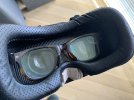

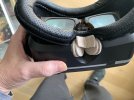
What got me curious about the DroneMask last year was that it didn't require a special program to use. No Litchi or DroneVR required. You can fly it with DJI fly or any other interface. How did it compare to the $28 VR goggles I got and reviews last year? While preliminary, the answers are mostly in. There are pros and cons to both types of non-DJI FPV/VR goggles.
First the Dronemask:

It's well built, but heavy. 450 grams, which wasn't noted in the specs. It's pretty easy to use. Clamp your phone in, turn on Fly, Go4, Litchi (in normal mode and you're ready to go. It has focus adjustment that moves the outer housing closer or further away. I you happen to need reading glass magnification it moves further away. However the it creates a longer lever arm on the "fulcrum" of the straps that hang on your head. That increases perceived weight significantly. In my case I use an iPhone XR which itself weigh 250 grams. So I'm hanging 700 grams on my head. However it has GOOD adjustable straps so at least it stays put. They didn't skimp on materials but you pay for it with weight.
It works as described. Open the program, set the settings close it up and go. The one other big negative that I see is that the closure is used with zippers. Since the phone is held in place inside, a "clip" closure system would have been far more convenient. With drones that have the Mini 2 type controller it can be a pain because you don't have C1 and C2 buttons and the toggle and two scroll wheels like the Mavic 2 does. The good news is that since the phone is held in place you can pop open the front, make the changes and then zip it up a bit. The other thing is that I found it too heavy to stay on top of my head when I wanted to eyeball the drone.
Now the $28 VR goggles...

I've been using the Pecosa brand of VR Goggles and out of the box found them needing a lot of fixes. But $28? So I decided to stick with them for the time (last year). The thing is with VR Goggles you need an interface that has a split screen function, unlike the Dronemask (you are just looking at the phone screen, so you can use with any program- even regular movies/tv from your phone. The two programs that I found worked well were Litchi and DroneVR. I had been waiting until recently until Litchi supported the Mini 2. I'm not sure if DroneVR caught up yet (though it works great with my Mavic 2).
The Pecosa VR's weigh 291 grams, 160 grams lighter. These were lighter than the first pair of VR goggles I bought and returned, specifically because of the weight (and quality) issues. It has a pop-off front which lightens it up some if you take it off. It's held in magnetically, so I installed a tab to pop it off easily.
The main issues that I have with the Pecosa is comfort (out of the box) and adjustability for presbyopia (needing reading glasses). It's maximum adjustment wasn't enough for my modest presbyopia. So I ended up installing a pair of reading glasses inside, I also found that pushing the phone further away from the mounting face improved the focus adjustability. (see photos). The other issue that I had was that they didn't put the right padding/support at the nose, so I had to do some creative padding (with chair felts) which seems to work pretty well and puts the weight comfortably on my nose rather than just hanging off the back of my head. (see photos below)
Software comparison:
The one advantage of the VR goggles is that in conjunction with Litchi or Drone VR raising the head up and down moves the gimbal up and down without the controller's scroll wheel. With the Mavic 2, you can move the camera up and down but pan left and right as well. The coolest thing with that is that you can fly by something and continue to turn your head toward it and camera just points at it. Not available with the drones that don't have camera panning. But you can still tilt up and down. With DJI Fly or Go4 you do not have an FPV function, but with the Dronemask and Fly/Go4 all the control on the controller. What Dronemask is is an on-face image magnifier. Simple to use and can work with any drone and most reasonably sized phones.
So far I've only flown Dronemask for an indoor test because I don't have VO available. It seems to work reasonably well for what it is. But it's priced at $169, which is 6x the cost of the VR goggles. I'm on the fence about keeping them but will requires some more testing, hopefully in the next few days.
Bottom line; If you can utilize Litchi or DroneVR and don't mind a bit of customization, I think the VR goggles are a great buy. If you want simplicity of interface and a decent (but heavy) mask out of the box with no special software required, the Dronemask might be a good choice if you don't mind the price tag.
So that's the full comparison/review.







